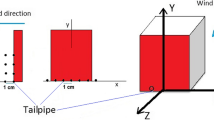Abstract
In a previous study, it was found that cargo tank operations like cleaning and venting, lead to higher cargo vapor concentrations around the ship’s superstructure. Can wind tunnel experiments confirm these findings? Is there an improvement when using higher outlets at high velocities compared to lower outlets with a low outlet velocity? Is there a relation between relative wind speed and measured concentration? These questions were investigated in the Peutz wind tunnel. By using a tracer gas for the wind tunnel experiments, concentration coefficients have been calculated for various settings. The study shows that using high-velocity outlets is an efficient way to keep concentrations as low as possible. The only exception is for relative wind directions from the bow. In this last case using a manhole as ventilation outlet leads to lower concentrations. With increasing wind speeds the building downwash effect resulted in higher concentration coefficients near the main deck. This study confirms our on-board measurements and suggests the lowering of the ventilation inlet of the accommodation, so that the high-velocity outlet can be used safely at all times.





Similar content being viewed by others
References
Jacobs W et al (2011) Benzene concentrations on board of chemical tankers. WMU J Marit Aff 10:117–126
Argyriadis K (2003) Wind conditions for offshore wind turbine design, RECOFF, comparison of standards and regulations, paper presented at the 3rd experts meeting on wind conditions for turbine design. Int Energy Agency, Paris
Det Norske Veritas (2010) Recommended practice, DNV-RP-C205, Environmental conditions and environmental loads. http://www.dnv.com
Danish Energy Agency/Risø (2001) Danish recommendation for technical approval of offshore wind turbines
Burton T, Jenkins N, Sharpe D, Bossanyi E (2011) Wind energy handbook, 2nd edn. Wiley, West Sussex, p 780, ISBN:978-0-470-69975-1
The International Maritime Organisation (2007) The international code for the construction and equipment of ships carrying dangerous chemicals in bulk (IBC code). The International Maritime Organisation, London, p 259
Posti A, Häkkinen J (2012) Survey of transportation of liquid bulk chemicals in the Baltic Sea. Publications from the centre for maritime studies, University of Turku, Turku, p 78, ISBN:978-951-29-5000-3
Bradstreet JW (1995) Hazardous air pollutants: assessment, liabilities, and regulatory compliance. Noyes Publications, Saddle River, p 406
Pennequin-Cardinal A, Plaisance H, Locoge N, Ramalho O, Kirchner S, Galloo JC (2005) Performances of the Radiello diffusive sampler for BTEX measurements: influence of environmental conditions and determination of modelled sampling rates. Atmos Environ 39:2535–2544
Plaisance H, Leonardis T, Gerboles M (2008) Assessment of uncertainty of benzene measurements by Radiello diffusive sampler. Atmos Environ 42:2555–2568
Mavroidis I, Griffiths RF, Hall DJ (2003) Field and wind tunnel investigations of plume dispersion around single surface obstacles. Atmos Environ 37:2903–2918
Gupta A, Stathopoulos T (2012) Tracer gas dispersion in an urban environment: scaling considerations in wind tunnel testing. J Wind Eng 9:20–32
Acknowledgments
The authors would like to thank Peutz bv. at Molenhoek, the Netherlands, for providing the wind tunnel facilities and their assistance during the various stages of this research.
Author information
Authors and Affiliations
Corresponding author
Electronic supplementary material
Below is the link to the electronic supplementary material.
About this article
Cite this article
Jacobs, W., Reynaerts, C., Andries, S. et al. Analyzing the dispersion of cargo vapors around a ship’s superstructure by means of wind tunnel experiments . J Mar Sci Technol 21, 758–766 (2016). https://doi.org/10.1007/s00773-016-0387-9
Received:
Accepted:
Published:
Issue Date:
DOI: https://doi.org/10.1007/s00773-016-0387-9




